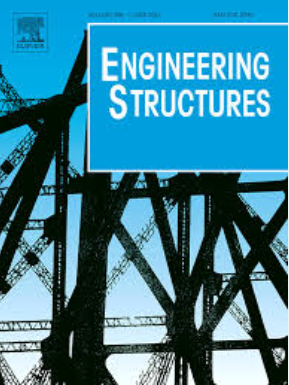Strengthening of high-strength RC continuous deep beams having rectangular web openings using bolted steel plates
IF 6.4
1区 工程技术
Q1 ENGINEERING, CIVIL
引用次数: 0
Abstract
Continuous high-strength concrete (HSC) deep beams are commonly encountered in various structures, often requiring the incorporation of post-construction openings for electrical and sanitary facilities, as well as utility pipes. This research focuses on experimental testing of three two-span HSC deep beams: one reference specimen without openings, one specimen having post-construction rectangular openings, and one strengthened specimen having rectangular openings. Two asymmetrical rectangular openings were made (one in each span). One opening simulated cutting the exterior strut of the first span, and the other one represented cutting the interior strut of the second span of the continuous deep beam. The strengthening technique involved attaching steel plates with anchor bolts around the cutouts. It is revealed that the beam having openings experienced a 45 % reduction in the peak load compared to the reference specimen. However, the upgraded specimen not only restored the peak load but also surpassed it by 9 % compared to the reference specimen and 98 % enhancement over the specimen with openings. Nonlinear two-dimensional (2D) finite element (FE) modeling validated the test outcomes and facilitated a parametric study on the strengthened beam. The analysis revealed that welding of the upper and lower chords with interior steel box had more significant impact on the strengthening effectiveness than steel plate thickness alone. The analysis indicated that the steel plate used in tests was on the higher side, as a lesser plate thickness was sufficient. Moreover, the interior steel box alone within the opening produced a 28 % enhancement in the peak strength.
具有矩形腹板开口的高强度钢筋混凝土连续深梁的锚固加固
连续高强度混凝土(HSC)深梁通常在各种结构中遇到,通常需要在施工后为电气和卫生设施以及公用管道提供开口。本研究对3根两跨HSC深梁进行了试验测试:1根无开口的参考试件,1根有施工后矩形开口的试件,1根有矩形开口的加固试件。两个不对称的矩形开口(每个跨度一个)。一个开孔模拟切割第一跨的外支撑,另一个开孔模拟切割第二跨的内支撑。加固技术包括将钢板与地脚螺栓固定在切口周围。结果表明,与参考试样相比,具有开口的梁的峰值载荷降低了45% %。然而,升级后的试件不仅恢复了峰值荷载,而且比参考试件高出9 %,比开孔试件高出98 %。非线性二维(2D)有限元(FE)建模验证了试验结果,并便于对加固梁进行参数化研究。分析表明,上下弦与内钢盒的焊接比钢板厚度对加固效果的影响更显著。分析表明,试验中使用的钢板偏高,因为较小的钢板厚度就足够了。此外,仅在开口内的内部钢箱就产生了28% %的峰值强度提高。
本文章由计算机程序翻译,如有差异,请以英文原文为准。
求助全文
约1分钟内获得全文
求助全文
来源期刊

Engineering Structures
工程技术-工程:土木
CiteScore
10.20
自引率
14.50%
发文量
1385
审稿时长
67 days
期刊介绍:
Engineering Structures provides a forum for a broad blend of scientific and technical papers to reflect the evolving needs of the structural engineering and structural mechanics communities. Particularly welcome are contributions dealing with applications of structural engineering and mechanics principles in all areas of technology. The journal aspires to a broad and integrated coverage of the effects of dynamic loadings and of the modelling techniques whereby the structural response to these loadings may be computed.
The scope of Engineering Structures encompasses, but is not restricted to, the following areas: infrastructure engineering; earthquake engineering; structure-fluid-soil interaction; wind engineering; fire engineering; blast engineering; structural reliability/stability; life assessment/integrity; structural health monitoring; multi-hazard engineering; structural dynamics; optimization; expert systems; experimental modelling; performance-based design; multiscale analysis; value engineering.
Topics of interest include: tall buildings; innovative structures; environmentally responsive structures; bridges; stadiums; commercial and public buildings; transmission towers; television and telecommunication masts; foldable structures; cooling towers; plates and shells; suspension structures; protective structures; smart structures; nuclear reactors; dams; pressure vessels; pipelines; tunnels.
Engineering Structures also publishes review articles, short communications and discussions, book reviews, and a diary on international events related to any aspect of structural engineering.
 求助内容:
求助内容: 应助结果提醒方式:
应助结果提醒方式:


